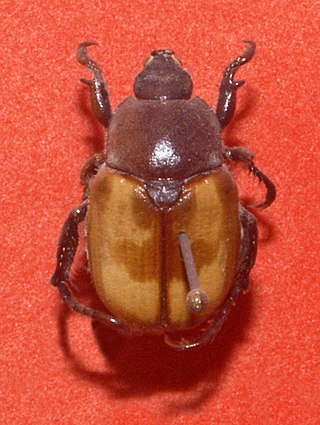
Flower chafers are a group of scarab beetles comprising the subfamily Cetoniinae. Many species are diurnal and visit flowers for pollen and nectar, or to browse on the petals. Some species also feed on fruit. The group is also called fruit and flower chafers, flower beetles and flower scarabs. There are around 4,000 species, many of them still undescribed.

Carabus is a genus of beetles in the family Carabidae. The genus is highly diverse with 94 subgenera, 959 species and 2300 subspecies, thus is the largest genus in the subfamily Carabinae. The vast majority are native to the Palearctic, but 16 Nearctic species are also known. Carabus spp. are 12–50 mm (0.47–1.97 in) long, and most species are wingless and often very colourful. These are nocturnal, predatory beetles that feed on snails, earthworms, and caterpillars. Most Carabus species were thought to have inhabited the Eurasian forest, but the species' low dispersal abilities altered the distribution of lineages within the genus.

Pelidnota is a genus of beetles of the family Scarabaeidae. There are more than 180 described species in Pelidnota, found in the Neotropics.

Anisoplia is a genus of shining leaf chafers in the family Scarabaeidae.

Ceraspis is a genus of beetles in the subfamily Melolonthinae. It is Neotropical, ranging from Mexico to Argentina.
Schizognathina, Ohaus, 1918, is a subtribe of scarab beetles, belonging to the tribe Anoplognathini.

Rutelini is a tribe of shining leaf chafers in the family Scarabaeidae. There are about 14 genera and at least 40 described species in Rutelini.
Brahmina is a large Palearctic genus of scarab beetles in the tribe Melolonthini, containing over 90 species in three subgenera.
Geniatini is a tribe of shining leaf chafers in the family Scarabaeidae. There are about 10-13 genera and at over 300 described species in Rutelini.

Paranomala is a genus of shining leaf chafers in the beetle family Scarabaeidae. There are more than 190 described species in Paranomala, found in North, Central, and South America, and in southern Asia.





